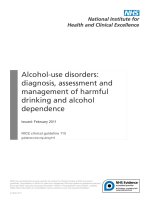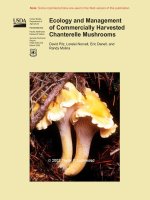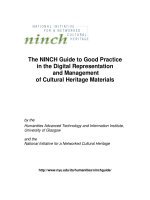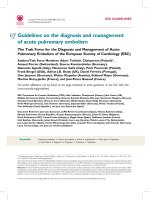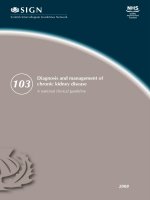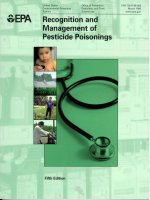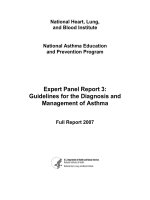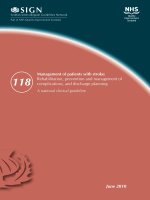Recognition and Management of Pesticide Poisonings docx
Bạn đang xem bản rút gọn của tài liệu. Xem và tải ngay bản đầy đủ của tài liệu tại đây (2.89 MB, 243 trang )
R ECOGNITION AND
M ANAGEMENT OF
P ESTICIDE POISONINGS
Fifth Edition, 1999
J. Routt Reigart, M.D.
Professor of Pediatrics, Medical University of South Carolina
James R. Roberts, M.D., M.P.H.
Assistant Professor of Pediatrics, Medical University of South Carolina
Support for this publication was provided by:
Certification and Worker Protection Branch
Field and External Affairs Division
Office of Pesticide Programs
U.S. Environmental Protection Agency
401 M Street SW (7506C)
Washington, DC 20460
For additional copies or more information:
Tel: 703-305-7666
Fax: 703-308-2962
The manual is available in electronic format on the Internet at:
/>Acknowledgments
We are grateful to the Office of Pesticide Programs, Environmental Protection Agency, for giving us the
opportunity to collaborate on this new edition. Our thanks go to Kevin Keaney, Acting Branch Chief, for
his support and vision, and for giving this publication priority attention. Particular mention should also be
made of the efforts of Jerome M. Blondell, Ph.D., M.P.H., and Ameesha Mehta, M.P.H., whose oversight
and constant assistance were invaluable in moving this project forward. Ana Maria Osorio, M.D., M.P.H.,
contributed Chapter 3, Environmental and Occupational History, to this manual.
Experts in clinical toxicology conducted critical reviews of draft material. We are greatly appreciative
of the time and effort of the following reviewers:
Jeffery Lloyd Burgess, M.D., M.P.H.
Assistant Professor
Environmental Occupational Health Unit
University of Arizona Prevention Center
Matthew C. Keifer, M.D., M.P.H.
Assistant Professor
Department of Medicine/Environmental Health
University of Washington
Wayne R. Snodgrass, M.D., Ph.D.
Professor and Head
Clinical Pharmacology-Toxicology
Texas Poison Center
Sheldon L. Wagner, M.D.
Professor of Clinical Toxicology
Oregon State University
Many other individuals contributed their time and skill to this publication. We are very appreciative
of the tireless efforts of Patricia Clark, our administrative assistant, who spent endless hours in text
review, securing references, communicating with reviewers, and otherwise making the revision process
possible and easier than anticipated. Gilah Langner of Stretton Associates, Inc., provided editorial super-
vision. Will Packard and Sarah Carter of Free Hand Press, Inc. were responsible for the format and
layout of the manual.
Cover photographs by Steve Delaney, EPA.
Section I: General Information
1 Introduction 2
2 General Principles in the Management of Acute Pesticide Poisonings 10
3 Environmental and Occupational History 17
Section II: Insecticides
4 Organophosphate Insecticides 34
5 N-Methyl Carbamate Insecticides 48
6 Solid Organochlorine Insecticides 55
7 Biologicals and Insecticides of Biological Origin 63
8 Other Insecticides, Acaricides, and Repellents 74
Section III: Herbicides
9 Chlorophenoxy Herbicides 94
10 Pentachlorophenol 99
11 Nitrophenolic and Nitrocresolic Herbicides 104
12 Paraquat and Diquat 108
13 Other Herbicides 118
Section IV: Other Pesticides
14 Arsenical Pesticides 126
15 Fungicides 137
16 Fumigants 156
17 Rodenticides 169
18 Miscellaneous Pesticides, Solvents, and Adjuvants 183
19 Disinfectants 196
Section V
Index of Signs and Symptoms 210
Index of Pesticide Products 223
CONTENTS
List of Tables
Dosage Tables
Sorbitol 12
Activated Charcoal 13
Syrup of Ipecac 14
Diazepam 14
Lorazepam 15
Atropine 42
Pralidoxime 43
Atropine 51
Diazepam 58
Atropine Sulfate 68, 72
Calcium Gluconate 84
Lorazepam 102
Bentonite and Fullers Earth 113
Morphine Sulfate 115
BAL (Dimercaprol) 130
D-penicillamine 131
DMSA (Succimer) 131
DMPS 131
Cyanide Antidotes 166
Supplemental Sodium Nitrite and Sodium Thiosulfate 167
Phytonadione 171
Aquamephyton
®
172
Calcium Gluconate 178
Tables
Pesticides Most Often Implicated in Symptomatic Illnesses, 1996 5
California Occupational Illnesses Due to Pesticides, 1991-1995 6
Screening Questions for Occupational and Environmental Exposures 18
Adult Interview for Occupational and Environmental Exposures 26
Steps in Investigating a Disease Outbreak 26
Approximate Lower Limits of Normal Plasma and
Red Cell Cholinesterase Activities in Humans 39
Toxicity of Common Herbicides 119
Section I
GENERAL INFORMATION
2 INTRODUCTION
CHAPTER 1
Introduction
This fifth edition of Recognition and Management of Pesticide Poisonings is an up-
date and expansion of the 1989 fourth edition. The Office of Pesticide Pro-
grams of the United States Environmental Protection Agency has sponsored
the series since 1973. The purpose of the manual is to provide health profes-
sionals with recently available information on the health hazards of pesticides
currently in use, and current consensus recommendations for management of
poisonings and injuries caused by them.
Pesticide poisoning is a commonly under-diagnosed illness in America to-
day. Despite recommendations by the Institute of Medicine and others urging
the integration of environmental medicine into medical education, health care
providers generally receive a very limited amount of training in occupational
and environmental health, and in pesticide-related illnesses, in particular.
1
The
updating of this manual is part of a larger initiative of the U.S. Environmental
Protection Agency, in conjunction with numerous federal agencies, associa-
tions of health professionals, and related organizations to help health care
providers become better aware, educated, and trained in the area of pesticide-
related health concerns. This larger initiative, entitled Pesticides and National
Strategies for Health Care Providers, was launched in April 1998.
As with previous updates, this new edition incorporates new pesticide prod-
ucts that are not necessarily widely known among health professionals. The
accumulated use experience of formulators, applicators, and field workers
provides an expanding basis for judging safety and identifying the environmen-
tal and workplace hazards of old and new pesticides. Major episodes of adverse
health effects reported in medical and scientific periodicals have been taken
into account. This literature also contributes importantly to improved under-
standing of toxic mechanisms. Clinical toxicology is a dynamic field of medi-
cine; new treatment methods are developed regularly, and the effectiveness of
old as well as new modalities is subject to constant critical review.
There is general agreement that prevention of pesticide poisoning remains a
much surer path to safety and health than reliance on treatment. In addition to
the inherent toxicity of pesticides, none of the medical procedures or drugs
used in treating poisonings is risk-free. In fact, many antidotes are toxic in their
own right, and such apparently simple procedures as gastric intubation incur
substantial risk. The clinical toxicologist must often weigh the hazards of vari-
ous courses of actionsometimes including no treatment at allagainst the
risks of various interventions, such as gastric emptying, catharsis, administration
INTRODUCTION 3
of intravenous fluids, or administration of an antidote, if available. Clinical man-
agement decisions have to be made promptly and, as often as not, on the basis
of limited scientific and medical information. The complex circumstances of
human poisonings rarely allow precise comparisons of alternative management.
In no sense, then, are the treatment recommendations in this book infallible
guides to successful outcomes. They are no more than consensus judgments of
the best available clinical management options.
This manual deals almost entirely with short-term (acute) harmful effects
of pesticides. Although obviously important, the subject of chronic effects is
too complex to deal with exhaustively in a manual designed as guidance for
emergency management. Nonetheless, appropriate treatment of serious expo-
sures to pesticides represents an important step in avoiding chronic as well as
acute disease.
The pesticides and commercial products mentioned in this manual do not
represent the universe of pesticide products in existence. They were selected
based on frequency of use and exposure, severity of toxicity, and prior experi-
ence with acute poisonings. Products are discussed in this manual that have
been discontinued or whose U.S. pesticide registration has been revoked but
are judged to still be of risk due to use elsewhere or where there is a probability
of residual stocks. Agents long out of use in the U.S. and elsewhere were not
included in the manual.
The amount of pesticide absorbed is a critical factor in making treatment
decisions, and estimation of dosage in many circumstances of pesticide expo-
sure remains difficult. The terms small amount and large amount used in
this book are obviously ambiguous, but the quality of exposure information
obtained rarely justifies more specific terminology.
Sometimes the circumstances of exposure are a rough guide to the amount
absorbed. Exposure to spray drift properly diluted for field application is not
likely to convey a large dose unless exposure has been prolonged. Spills of
concentrated technical material onto the skin or clothing may well represent a
large dose of pesticide unless the contamination is promptly removed. Brief
dermal exposure to foliage residues of cholinesterase-inhibiting pesticides is
not likely to lead to poisoning, but prolonged exposures may well do so. Sui-
cidal ingestions almost always involve large amounts, requiring the most ag-
gressive management. Except in children, accidental pesticide ingestions are
likely to be spat out or vomited. Ingestions of pesticides by children are the
most difficult to evaluate. The therapist usually must base clinical management
decisions on worst case assumptions of dosage. Childhood poisonings are still
further complicated by the greater vulnerability of the very young, not only to
pesticides themselves, but also to drugs and treatment procedures. The nature
of neurological development in children entails an additional level of risk that
is not present in adults. Some adult groups such as farmwrokers with poor
nutrition and high exposure may also be at increased risk.
4 INTRODUCTION
Key Principles
General methods of managing pesticide poisonings are presented in Chap-
ter 2 and reflect a broad base of clinical experience. The following key points
deserve emphasis. The need to protect the airway from aspiration of vomitus
cannot be overstated. Death has occasionally resulted from this complication,
even following ingestions of substances having relatively low toxic potential. In
poisonings by agents that depress central nervous system function or cause
convulsions, early placement of a cuffed endotracheal tube (even when this
requires light general anesthesia) may be life saving. Maintenance of adequate
pulmonary gas exchange is another essential element of poisoning manage-
ment that deserves constant reemphasis.
Gastric intubation, with aspiration and lavage, remains a useful method for
removing poisons from the stomach shortly after they have been swallowed,
but the time after ingestion during which lavage is likely to be beneficial is
shorter than many clinical toxicologists have thought. Rarely are significant
amounts of swallowed toxicants recovered more than 1-2 hours after ingestion,
and, in many instances, the bulk of swallowed material passes into the duode-
num and beyond in 15-30 minutes. In addition, the majority of controlled
studies evaluating the effectiveness of gastric emptying procedures are done for
ingestions of solid material (pills) rather than liquids.
Full advantage should be taken of new highly adsorbent charcoals that are
effective in binding some pesticides in the gut. Unfortunately, charcoal does
not adsorb all pesticides, and its efficiency against many of them is not known.
In poisonings caused by large intakes of pesticide, hemodialysis and
hemoperfusion over adsorbents continue to be tested as methods for reducing
body burdens. Against some toxicants, these procedures appear valuable. Over-
all effectiveness appears to depend not only on efficiency of clearance from the
blood, but also on the mobility of toxicant already distributed to tissues before
the extracorporeal blood-purification procedure is started. The volume of dis-
tribution and avidity of tissue binding are important considerations in making
such decisions. The critical determinant of success in using these systems may
well be the speed with which they can be put into operation before tissue-
damaging stores of toxicant have accumulated.
There remains a need for systematic reporting of pesticide poisonings to a
central agency so that accurate statistics describing the frequency and circum-
stances of poisoning can be compiled, and efforts to limit these occurrences can
be properly directed. In some countries there has been an increase in the use of
pesticides as instruments of suicide and even homicide. Producers are now
devoting considerable effort to modifying formulation and packaging to deter
these misuses. This work is important because suicidal ingestions are often the
most difficult pesticide poisonings to treat successfully.
INTRODUCTION 5
Common Pesticide Poisonings
The pesticides most often implicated in poisonings, injuries, and illnesses,
according to 1996 data from the American Association of Poison Control Centers
Toxic Exposure Surveillance System, are listed below.
The list is based on symptomatic cases classified as minor, moderate, major,
or fatal outcome for unintentional cases involving a single product. Numbers
of cases are reported for both children under six years of age and for adults and
older children. Suicide/homicide (intentional) cases have been excluded. Cases
listed as organophosphates (and the other categories as well) may also include
other insecticides such as carbamates and organochlorines in a single product.
PESTICIDES MOST OFTEN IMPLICATED IN SYMPTOMATIC
ILLNESSES, 1996
Rank Pesticide or Pesticide Class Child Adults Total*
< 6 years 6-19 yrs.
1 Organophosphates 700 3274 4002
2 Pyrethrins and pyrethroids** 1100 2850 3950
3 Pine oil disinfectants 1336 903 2246
4 Hypochlorite disinfectants 808 1291 2109
5 Insect repellents 1081 997 2086
6 Phenol disinfectants 630 405 1040
7 Carbamate insecticides 202 817 1030
8 Organochlorine insecticides 229 454 685
9 Phenoxy herbicides 6 3 387 453
1 0 Anticoagulant rodenticides 176 3 3 209
All Other Pesticides 954 3604 4623
Total all pesticides/disinfectants 7279 15,015 22,433
* Totals include a small number of cases with unknown age.
** Rough estimate: includes some veterinary products not classified by chemical type.
Source: American Association of Poison Control Centers, Toxic Exposure Surveillance
System, 1996 data.
Approximately 90% of symptomatic cases involve only minor symptoms of
the type that could typically be treated at home with dilution or just observation.
However, seven of the top ten categories listed in the table above (organo-
phosphates, pyrethrins/pyrethroids, hypochlorite disinfectants, carbamates,
organochlorines, phenoxy herbicides, and anticoagulant rodenticides) are much
more likely to require medical attention.
This list cannot be considered representative of all symptomatic poisonings
because it only shows cases reported to Poison Control Centers. However, it does
give a sense of the relative frequency and risk of poisoning from various agents or
classes of agents. The relative frequency of cases generally reflects how widely a
product is used in the environment. For example, a number of disinfectants occur
in the top ten partly because they are far more commonly found in the home and
work environment than other pesticides (see also the table of occupational cases
6 INTRODUCTION
below). Denominator information on the population at risk (numbers exposed)
would be needed to better understand the relative risk of different pesticides.
However, the main purpose of these tables is to give physicians a sense of what
types of cases they are most likely to see in their practice.
Although suicide cases make up roughly 3% of pesticide-related calls to
Poison Control Centers, they may account for nearly 10% of the cases seen in
a health care facility. The leading types of products involved in suicidal cases
include anticoagulant rodenticides (20% of total suicide attempts), pine oil dis-
infectants (14%), organophosphates (11%), pyrethrins/pyrethroids (6%), unknown
rodenticides (5%), carbamate insecticides (4%), and phenol disinfectants (3%).
CALIFORNIA OCCUPATIONAL ILLNESSES LIKELY DUE TO
PESTICIDES, 1991-1995
Rank Pesticide Systemic Topical* Total
1 Sodium hypochlorite 167 858 1025
2 Quaternary ammonia 9 348 357
3 Chlorine 112 124 236
4 Glutaraldehyde 38 118 156
5 Chlorpyrifos 113 39 152
6 Sulfur 48 69 117
7 Glyphosate 9 94 103
8 Propargite 3 9 6 99
9 Metam sodium** 6 4 33 97
1 0 Cyanuric acid 1 4 7 6 9 0
All Other 1149 1089 2238
Total all pesticides/disinfectants 1726 2944 4670
* Topical includes skin, eye, and respiratory effects.
** Train derailment led to a cluster of cases due to metam sodium in 1991.
Source: Louise Mehler, M.S., California Pesticide Illness Surveillance Program, California
Environmental Protection Agency.
Poison Control Centers are best at capturing pesticide exposures which
occur in residential environments. However, occupational exposures are not as
well covered. Californias Pesticide Illness Surveillance Program is generally
regarded as the best in the country. The table above presents the number of
occupationally-related cases in California reported from 1991 through 1995
where a pesticide was considered a probable or definite cause of the resulting
illness. Pesticide combinations, where the primary pesticide responsible for the
illness could not be identified, are not included in this table. Among persons
who encounter pesticides in the course of their occupational activities, dermal
and eye injuries, rather than systemic poisonings, are more common. Systemic
poisonings, however, are likely to be more severe.
INTRODUCTION 7
Format of this Manual
An effort has been made to format this book for quick reference by thor-
ough indexing and minimal references to other pages or chapters. However,
many different agents commonly require similar procedures in treating poison-
ings and it is not practical to repeat these protocols in every chapter. General
principles for management of pesticide poisoning, including skin and eye de-
contamination, gastrointestinal decontamination, and control of convulsions
are considered in Chapter 2, General Principles. These principles are refer-
enced throughout.
Changes in this reformatted edition include: tabular listings of Commercial
Products in each chapter, the addition of a new chapter on Disinfectants (Chapter
19), and the addition of a chapter on Environmental and Occupational History
(Chapter 3), which places pesticide poisonings in the context of other environ-
mental and occupational exposures, provides questionnaires designed to elicit ex-
posure information, discusses resources available to the practitioner, and provides a
list of governmental and non-government contacts and Web sites for more infor-
mation. In addition, each chapter is referenced to key references in readily accessible
current literature. Most references were selected as primary references in peer
review journals, although some review papers are also included.
The contents of this book have been derived from many sources: published
texts, current medical, toxicological, and pesticide product literature, and direct
communications with experts in clinical toxicology and pesticide toxicology and
environmental and occupational health specialists. A list of the major text sources
follows this introduction.
Reference
1. Institute of Medicine. Role of the Primary Care Physician in Occupational and Environ-
mental Medicine, Washington, DC: Institute of Medicine, 1988.
Texts and Handbooks on Pesticides,
Pesticide Toxicology, and Clinical Toxicology
Agricultural Chemicals Books I, II, III, IV
W.T. Thomson
Thomson Publications, Fresno, CA, 1994-95
Agrochemicals Desk Reference: Environmental Data
John H. Montgomery
Lewis Publishers, Boca Raton, FL, 1995
The Agrochemicals Handbook, 3rd Edition
The Royal Society of Chemistry, Cambridge, England, 1994
8 INTRODUCTION
Biological Monitoring Methods for Industrial Chemicals,
2nd Edition
Randall C. Baselt
Biomedical Publications, Davis, CA, 1988
Casarett and Doulls Toxicology, 5th Edition
John Doull, Curtis D. Klaassen, and Mary O. Amdur
Macmillan Publishing Company, New York, NY, 1996
Chemicals Identified in Human Biological Media: A Data Base
Compiled by M. Virginia Cone, Margaret F. Baldauf, Fay M. Martin, and John
T. Ensminger
Oak Ridge National Laboratory, 1980
Clinical Toxicology of Agricultural Chemicals
Sheldon L. Wagner, M.D.
Oregon State University Press, Corvallis, OR, 1981
Clinical Toxicology of Commercial Products, 5th Edition
Robert E. Gosselin, Roger P. Smith and Harold C. Hodge, with assistance of
Jeannette E. Braddock
Williams and Wilkins, Baltimore, MD, 1984
Farm Chemicals Handbook
Charlotte Sine, Editorial Director
Meister Publishing Company, Willoughby, Ohio, 1998
Handbook of Pesticide Toxicology
Wayland J. Hayes, Jr. and Edward R. Laws, Jr., Editors
Academic Press, San Diego, CA 1991
Handbook of Poisoning: Prevention, Diagnosis and Treatment,
12th Edition
Robert H. Dreisbach and William O. Robertson
Appleton and Lange, East Norwalk, CT, 1987
Herbicide Handbook, 7th Edition
Weed Science Society of America, 1994
Medical Toxicology: Diagnosis and Treatment of Human Poisoning
Matthew J. Ellenhorn and Donald G. Barceloux
Elsevier, New York, NY, 1988
INTRODUCTION 9
The Merck Index, 11th Edition
Martha Windholz and Susan Budavari, Editors
Merck and Company, Inc., Rahway, NJ, 1989
Pattys Industrial Hygiene and Toxicology, 4th Revised Edition
George D. Clayton and Florence E. Clayton
Wiley Interscience, New York, NY, 1991-95
Pesticide Manual, 11th Edition
CDS Tomlin
The British Crop Protection Council, Farnham, Surrey, United Kingdom,1997
Pesticide Profiles: Toxicity, Environmental Impact, and Fate
Michael A. Kamrin (Editor)
Lewis Publishers, Boca Raton, FL, 1997
The Pharmacological Basis of Therapeutics, 8th Edition
Louis S. Goodman and Alfred Gilman
Pergamon Press, New York, NY, 1990
POISINDEX
®
System
Barry H. Rumack, N.K. Sayre, and C.R. Gelman, Editors
Micromedex, Englewood, CO, 1974-98
Poisoning: A Guide to Clinical Diagnosis and Treatment, 2nd Edition
W. F. Von Oettingen
W. B. Saunders Company, Philadelphia, PA, 1958
10 GENERAL PRINCIPLES
CHAPTER 2
General Principles in
the Management of
Acute Pesticide Poisonings
This chapter describes basic management techniques applicable to most acute
pesticide poisonings. Where special considerations and treatments are required
for a particular pesticide, they are addressed separately in the appropriate chapter.
Skin Decontamination
Decontamination must proceed concurrently with whatever resuscitative
and antidotal measures are necessary to preserve life. Shower patient with soap
and water, and shampoo hair to remove chemicals from skin and hair. If there
are any indications of weakness, ataxia, or other neurologic impairment, cloth-
ing should be removed and a complete bath and shampoo given while the
victim is recumbent. The possibility of pesticide sequestered under fingernails
or in skin folds should not be overlooked.
Flush contaminating chemicals from eyes with copious amounts of clean
water for 10-15 minutes. If eye irritation is present after decontamination, oph-
thalmologic consultation is appropriate.
Persons attending the victim should avoid direct contact with heavily con-
taminated clothing and vomitus. Contaminated clothing should be promptly
removed, bagged, and laundered before returning. Shoes and other leather items
cannot usually be decontaminated and should be discarded. Note that pesti-
cides can contaminate the inside surfaces of gloves, boots, and headgear. De-
contamination should especially be considered for emergency personnel such
as ambulance drivers at the site of a spill or contamination. Wear rubber gloves
while washing pesticide from skin and hair of patient. Latex and other surgical
or precautionary gloves usually will not always adequately protect from pesti-
cide contamination, so only rubber gloves are appropriate for this purpose.
Airway Protection
Ensure that a clear airway exists. Suction any oral secretions using a large
bore suction device if necessary. Intubate the trachea if the patient has respira-
tory depression or if the patient appears obtunded or otherwise neurologically
GENERAL PRINCIPLES 11
impaired. Administer oxygen as necessary to maintain adequate tissue oxygen-
ation. In severe poisonings, it may be necessary to mechanically support pul-
monary ventilation for several days.
Note on Specific Pesticides: There are several special considerations
with regard to certain pesticides. In organophosphate and carbamate poi-
soning, adequate tissue oxygenation is essential prior to administering atropine.
As important, in paraquat and diquat poisoning, oxygen is contraindicated
early in the poisoning because of progressive oxygen toxicity to the lung tissue.
See specific chapters for more details.
Gastrointestinal Decontamination
A joint position statement has recently been released by the American
Academy of Clinical Toxicology and the European Association of Poisons Centres
and Clinical Toxicologists on various methods of gastrointestinal decontamina-
tion. A summary of the position statement accompanies the description of
each procedure.
1. Gastric Lavage
If the patient presents within 60 minutes of ingestion, lavage may be con-
sidered. Insert an orogastric tube and follow with fluid, usually normal saline.
Aspirate back the fluid in an attempt to remove any toxicant. If the patient is
neurologically impaired, airway protection with a cuffed endotracheal tube is
indicated prior to gastric lavage.
Lavage performed more than 60 minutes after ingestion has not proven to
be beneficial and runs the risk of inducing bleeding, perforation, or scarring
due to additional trauma to already traumatized tissues. It is almost always nec-
essary first to control seizures before attempting gastric lavage or any other
method of GI decontamination.
Studies of poison recovery have been performed mainly with solid mate-
rial such as pills. There are no controlled studies of pesticide recovery by these
methods. Reported recovery of material at 60 minutes in several studies was
8%-32%.
1,2
There is further evidence that lavage may propel the material into
the small bowel, thus increasing absorption.
3
Note on Specific Pesticides: Lavage is contraindicated in hydrocarbon
ingestion, a common vehicle in many pesticide formulations.
Position Statement: Gastric lavage should not be routinely used in the
management of poisons. Lavage is indicated only when a patient has ingested a
potentially life-threatening amount of poison and the procedure can be done
within 60 minutes of ingestion. Even then, clinical benefit has not been con-
firmed in controlled studies.
4
12 GENERAL PRINCIPLES
2. Catharsis
Sorbitol and magnesium citrate are commonly used cathartic agents. Be-
cause magnesium citrate has not been studied as much, its use is not described
here. Sorbitol is often included in charcoal formulations. It will increase gut
motility to improve excretion of the charcoal-poison complex. The dosage of
sorbitol is 1-2 g/kg as a one-time dose. Repeat doses of cathartics may result in
fluid and electrolyte imbalances, particularly in children, and are therefore not
recommended. Sorbitol is formulated in 70% and 35% solutions and usually
packaged in 100 mL bottles. The gram dosage of sorbitol in a 100 mL bottle
can be calculated by multiplying 100 (mL) x 0.7 (for 70% solution) x 1.285 g
sorbitol/mL. Therefore the dose in mL is as follows:
Dosage of Sorbitol:
Adults: 70% sorbitol, 1-2 mL/kg.
Children: 35% sorbitol, 1.5-2.3 mL/kg (maximum dosage: 50 g).
Note on Specific Pesticides: Significant poisoning with organophos-
phates, carbamates, and arsenicals generally results in a profuse diarrhea. Poi-
soning with diquat and to a lesser extent paraquat results in an ileus. The use of
sorbitol is not recommended in any of the above pesticide poisonings.
Position Statement: The administration of a cathartic alone has no role
in the management of the poisoned patient. There are no definite indications
for the use of cathartics in the management of the poisoned patient. Data are
conflicting with regard to use in combination with activated charcoal, and its
routine use is not endorsed. If a cathartic is used, it should be as a single dose in
order to minimize adverse effects. There are numerous contraindications,
including absent bowel sounds, abdominal trauma or surgery, or intestinal
perforation or obstruction. It is also contraindicated in volume depletion,
hypotension, electrolyte imbalance, or the ingestion of a corrosive substance.
5
3. Activated Charcoal Adsorption
Activated charcoal is an effective absorbent for many poisonings. Volunteer
studies suggest that it will reduce the amount of poison absorbed if given within
60 minutes.
6
There are insufficient data to support or exclude its use if time
from ingestion is prolonged, although some poisons that are less soluble may be
adsorbed beyond 60 minutes. Clinical trials with charcoal have been done with
poisons other than pesticides. There is some evidence that paraquat is well
adsorbed by activated charcoal.
7,8
Charcoal has been anecdotally successful with
other pesticides.
GENERAL PRINCIPLES 13
Dosage of Activated Charcoal:
Adults and children over 12 years: 25-100 g in 300-800 mL water.
Children under 12 years: 25-50 g per dose.
Infants and toddlers under 20 kg: 1 g per kg body weight.
Many activated charcoal formulations come premixed with sorbitol. Avoid giv-
ing more than one dose of sorbitol as a cathartic in infants and children due to
the risk of rapid shifts of intravascular fluid.
Encourage the victim to swallow the adsorbent even though spontaneous vom-
iting continues. Antiemetic therapy may help control vomiting in adults or older
children. As an alternative, activated charcoal may be administered through an
orogastric tube or diluted with water and administered slowly through a nasogastric
tube. Repeated administration of charcoal or other absorbent every 2-4 hours may
be beneficial in both children and adults, but use of a cathartic such as sorbitol
should be avoided after the first dose. Repeated doses of activated charcoal should
not be administered if the gut is atonic. The use of charcoal without airway protec-
tion is contraindicated in the neurologically impaired patient.
Note on Specific Pesticides: The use of charcoal without airway pro-
tection should be used with caution in poisons such as organophosphates, car-
bamates, and organochlorines if they are prepared in a hydrocarbon solution.
Position Statement: Single-dose activated charcoal should not be used
routinely in the management of poisoned patients. Charcoal appears to be most
effective within 60 minutes of ingestion and may be considered for use for this
time period. Although it may be considered 60 minutes after ingestion, there is
insufficient evidence to support or deny its use for this time period. Despite
improved binding of poisons within 60 minutes, only one study exists
9
to suggest
that there is improved clinical outcome. Activated charcoal is contraindicated in
an unprotected airway, a GI tract not anatomically intact, and when charcoal
therapy may increase the risk of aspiration of a hydrocarbon-based pesticide.
6
4. Syrup of Ipecac
Ipecac has been used as an emetic since the 1950s. In a pediatric study,
administration of ipecac resulted in vomiting within 30 minutes in 88% of
children.
10
However, in light of the recent review of the clinical effectiveness of
ipecac, it is no longer recommended for routine use in most poisonings.
Most clinical trials involve the use of pill form ingestants such as aspirin,
2,11
acetaminophen,
12
ampicillin,
1
and multiple types of tablets.
13
No clinical trials
have been done with pesticides. In 1996, more than 2 million human exposures
to a poisonous substances were reported to American poison centers. Ipecac
was recommended for decontamination in only 1.8% of all exposures.
14
14 GENERAL PRINCIPLES
Dosage of Syrup of Ipecac:
Adolescents and adults: 15-30 mL followed immediately with 240 mL
of water.
Children 1-12 years: 15 mL preceded or followed by 120 to 240
mL of water.
Infants 6 months to 12 months: 5-10 mL preceded or followed by 120
to 240 mL of water.
Dose may be repeated in all age groups if emesis does not occur within
20-30 minutes.
Position Statement: Ipecac syrup should not be administered routinely
in poisoned patients. If ipecac is used, it should be administered within 60
minutes of the ingestion. Even then, clinical studies have demonstrated no ben-
efit from its use. It should be considered only in an alert conscious patient who
has ingested a potentially toxic ingestion. Contraindications to its use include
the following: patients with diminished airway protective reflexes, the ingestion
of hydrocarbons with a high aspiration potential, the ingestion of a corrosive
substance, or the ingestion of a substance in which advanced life support may
be necessary within the next 60 minutes.
15
5. Seizures
Lorazepam is increasingly being recognized as the drug of choice for status
epilepticus, although there are few reports of its use with certain pesticides.
One must be prepared to assist ventilation with lorazepam and any other medi-
cation used to control seizures. See dosage table on next page.
For organochlorine compounds, use of lorazepam has not been reported
in the literature. Diazepam is often used for this, and is still used in other pesti-
cide poisonings.
Dosage of Diazepam:
Adults: 5-10 mg IV and repeat every 5-10 minutes to maximum of
30 mg.
Children: 0.2-0.5 mg/kg IV every 5 minutes to maximum of 10 mg
in children over 5 years and 5 mg in children under 5 years.
GENERAL PRINCIPLES 15
Dosage of Lorazepam:
Adults: 2-4 mg/dose given IV over 2-5 minutes. Repeat if necessary
to a maximum of 8 mg in a 12 hour period.
Adolescents: Same as adult dose, except maximum dose is 4 mg.
Children under 12 years: 0.05-0.10 mg/kg IV over 2-5 minutes. Re-
peat if necessary .05 mg/kg 10-15 minutes after first dose, with a
maximum dose of 4 mg.
Caution: Be prepared to assist pulmonary ventilation mechanically if
respiration is depressed, to intubate the trachea if laryngospasm occurs,
and to counteract hypotensive reactions.
Phenobarbital is an additional treatment option for seizure control. Dos-
age for infants, children, and adults is 15-20 mg/kg as an IV loading
dose. An additional 5 mg/kg IV may be given every 15-30 minutes to a
maximum of 30 mg/kg. The drug should be pushed no faster than 1 mg/
kg/minute.
For seizure management, most patients respond well to usual management
consisting of benzodiazepines, or phenytoin and phenobarbital.
References
1. Tenenbein M, Cohen S, and Sitar DS. Efficacy of ipecac-induced emesis, orogastric lavage,
and activated charcoal for acute drug overdose. Ann Emerg Med 1987;16:838- 41.
2. Danel V, Henry JA, and Glucksman E. Activated charcoal, emesis, and gastric lavage in aspi-
rin overdose. Br Med J 1988;296:1507.
3. Saetta JP, March S, Gaunt ME, et al. Gastric emptying procedures in the self-poisoned pa-
tient: Are we forcing gastric content beyond the pylorus? J R Soc Med 1991;84:274-6.
4. American Academy of Clinical Toxicology, European Association of Poisons Centres and Clinical
Toxicologists. Position statement: Gastric lavage. J Toxicol Clin Toxicol 1997;35:711-9.
5. American Academy of Clinical Toxicology, European Association of Poisons Centres and
Clinical Toxicologists. Position statement: Cathartics. J Toxicol Clin Toxicol 1997;35:743-52.
6. American Academy of Clinical Toxicology, European Association of Poisons Centres and
Clinical Toxicologists. Position statement: Single-dose activated charcoal. J Toxicol Clin Toxicol
1997;35:721-41.
7. Gaudreault P, Friedman PA, and Lovejoy FH Jr. Efficacy of activated charcoal and magne-
sium citrate in the treatment of oral paraquat intoxication. Ann Emerg Med 1985;14:123-5.
8. Terada H, Miyoshi T, Imaki M, et al. Studies on in vitro paraquat and diquat removal by
activated carbon. J Exp Med 1994;41:31-40.
9. Merigian KS, Woodward M, Hedges JR, et al. Prospective evaluation of gastric emptying in
the self-poisoned patient. Am J Emerg Med 1990;8:479-83.
16 GENERAL PRINCIPLES
10. Robertson W. Syrup of ipecac: A slow or fast emetic? AJDC 1962;103:136-9.
11. Curtis RA, Barone J, and Giacona N. Efficacy of ipecac and activated charcoal/cathartic.
Arch Intern Med 1984;144:48-52.
12. McNamara RM, Aaron CK, Gemborys M, et al. Efficacy of charcoal cathartic versus ipecac in
reducing serum acetaminophen in a simulated overdose. Ann Emerg Med 1989;18:934-8.
13. Neuvonen PJ, Vartiainen M, and Tokola O. Comparison of activated charcoal and ipecac
syrup in prevention of drug absorption. Eur J Clin Pharmacol 1983;24:557-62.
14. Litovitz RL, Smilkstein M, Felberg L, et al. 1996 Annual Report of the American
Association of Poison Control Centers Toxic Exposure Surveillance System. Am J Emerg Med
1997;15:447-500.
15. American Academy of Clinical Toxicology, European Association of Poisons Centres and Clinical
Toxicologists. Position statement: Ipecac syrup. J Toxicol Clin Toxicol 1997;35:699-709.
17
ENVIRONMENTAL AND
OCCUPATIONAL HISTORY
CHAPTER 3
Environmental and
Occupational History
Pesticide poisonings may go unrecognized because of the failure to take a proper
exposure history. This chapter is intended to remedy this often overlooked area
by providing basic tools for taking a complete exposure history. In some situ-
ations where exposures are complex or multiple and/or symptoms atypical, it is
important to consider consultation with clinical toxicologists or specialists in
environmental and occupational medicine. Local Poison Control Centers should
also be considered when there are questions about diagnosis and treatment.
Although this manual deals primarily with pesticide-related diseases and
injury, the approach to identifying exposures is similar regardless of the specific
hazard involved. It is important to ascertain whether other non-pesticide ex-
posures are involved because of potential interactions between these hazards
and the pesticide of interest (e.g., pesticide intoxication and heat stress in agri-
cultural field workers). Thus, the following section on pesticide exposures should
be seen in the context of an overall exposure assessment.
Most pesticide-related diseases have clinical presentations that are similar
to common medical conditions and display nonspecific symptoms and physical
signs. Knowledge of a patients exposure to occupational and environmental
factors is important for diagnostic, therapeutic, rehabilitative and public health
purposes. Thus, it is essential to obtain an adequate history of any environmen-
tal or occupational exposure which could cause disease or exacerbate an exist-
ing medical condition.
In addition to the appropriate patient history-taking, one must also con-
sider any other persons that may be similarly exposed in the home, work or
community environment. Each environmental or occupational disease identi-
fied should be considered a potential sentinel health event which may require
follow-up activities to identify the exposure source and any additional cases. By
identifying and eliminating the exposure source, one can prevent continued
exposure to the initial patient and any other individuals involved.
Patients with these types of diseases may be seen by health care providers
that are not familiar with these conditions. If an appropriate history is obtained
and there appears to be a suspect environmental or occupational exposure, the
health care provider can obtain consultation with specialists (e.g., industrial
hygienists, toxicologists, medical specialists, etc.) in the field of environmental
and occupational health. For the more severe sentinel health events and those
18
ENVIRONMENTAL AND
OCCUPATIONAL HISTORY
that involve numerous exposed individuals, additional assistance can be ob-
tained by contacting the state health department, state regulatory agency (e.g.,
the agriculture department in the case of pesticide illness and injury), or other
related organizations (see list at end of chapter). Furthermore, some states re-
quire reporting of certain environmental and occupational conditions (e.g.,
pesticide case reporting in Arizona, California, Florida, Oregon, Texas, and
Washington).
This chapter reviews the types of questions to be asked in taking an occupa-
tional and environmental history (for both adult and pediatric patients), discusses
legal, ethical, and public health considerations, and lists information resources.
Taking an Exposure History
Given the time constraints of most health care providers, a few screening
questions are likely to be preferable to a lengthy questionnaire in identifying
occupational or environmental hazards. The screening questions below could
be incorporated into an existing general health questionnaire or routine
patient interview.
SCREENING QUESTIONS FOR OCCUPATIONAL
AND ENVIRONMENTAL EXPOSURES*
For an adult patient:
After establishing the chief complaint and history of the presenting illness:
What kind of work do you do?
(if unemployed) Do you think your health problems are related to your home
or other location?
(if employed) Do you think your health problems are related to your work? Are
your symptoms better or worse when you are at home or at work?
Are you now or have you previously been exposed to pesticides, solvents, or
other chemicals, dusts, fumes, radiation, or loud noise?
For a pediatric patient (questions asked of parent or guardian):
Do you think the patients health problems are related to the home, daycare,
school, or other location?
Has there been any exposure to pesticides, solvents or other chemicals, dusts,
fumes, radiation, or loud noise?
What kind of work do the parents or other household members engage in?
If the clinical presentation or initial medical history suggests a potential occu-
pational or environmental exposure, a detailed exposure interview is needed.
An extensive exposure history provides a more complete picture of pertinent
exposure factors and can take up to an hour. The detailed interview includes
questions on occupational exposure, environmental exposure, symptoms and
medical conditions, and non-occupational exposure potentially related to ill-
ness or injury. Although the focus is on pesticide exposures and related health
19
ENVIRONMENTAL AND
OCCUPATIONAL HISTORY
effects, concurrent non-pesticide exposures need to be considered in the over-
all patient health assessment. Questions typical of a detailed interview are listed
on the next several pages, preceded by special concerns in addressing exposures
of children and agricultural workers. For further details on taking a history for
all types of occupational and environmental hazards, consult the ATSDR mono-
graph entitled Taking an Exposure History
1
or a general occupational and
environmental medicine reference text.
2
Special Patient Populations
Children
In comparison to adults, children may be at greater risk from pesticide
exposures due to growth and developmental factors. Consideration of fetal,
infant, toddler or child characteristics is helpful in an exposure evaluation: physical
location, breathing zones, oxygen consumption, food consumption, types of
foods consumed and normal behavioral development.
3
Furthermore, transpla-
cental absorption and breast milk may pose additional routes of exposure. Al-
though environmental (and, at times, occupational) exposure to pesticides is
the focus of this chapter, the most significant hazard for children is uninten-
tional ingestion.
4
Thus, it is very important to ask about pesticides used and
stored in the home, day care facility, school, and play areas.
Agricultural Workers
Data from Californias mandatory pesticide poisoning reporting system would
imply an annual national estimate of 10,000-20,000 cases of farmworker poison-
ing.
5
However, it is believed that these figures still represent serious underreporting
due to the lack of medical access for many farmworkers and misdiagnosis by
some clinicians. For these high-risk patients, the exposure history should include
specific questions about the agricultural work being done. For example:
Are pesticides being used at home or work?
Were the fields wet when you were picking?
Was any spraying going on while you were working in the fields?
Do you get sick during or after working in the fields?
The use of pesticides in the residence and taking home agricultural pesticides or
contaminated work clothes that are not properly separated from other clothes
may pose hazards for other household members as well.
Obtaining Additional Pesticide Information
In addition to the patient history, it is often helpful to obtain further infor-
mation on suspect pesticide products. Two documents are useful starting points
20
ENVIRONMENTAL AND
OCCUPATIONAL HISTORY
DETAILED INTERVIEW FOR OCCUPATIONAL
AND ENVIRONMENTAL EXPOSURES
(Questions marked in bold type are especially important for a pesticide exposure history)
(1) Adult Patient
OCCUPATIONAL EXPOSURE
What is your occupation? (If unemployed, go to next section)
How long have you been doing this job?
Describe your work and what hazards you are exposed to (e.g., pesticides, solvents or other
chemicals, dust, fumes, metals, fibers, radiation, biologic agents, noise, heat, cold, vibration)
Under what circumstances do you use protective equipment? (e.g., work clothes, safety glasses,
respirator, gloves, and hearing protection)
Do you smoke or eat at the worksite?
List previous jobs in chronological order, include full and part-time, temporary, second jobs,
summer jobs, and military experience. (Because this question can take a long time to answer, one
option is to ask the patient to fill out a form with this question on it prior to the formal history taking by
the clinician. Another option is to take a shorter history by asking the patient to list only the prior jobs
that involved the agents of interest. For example, one could ask for all current and past jobs involving
pesticide exposure.)
ENVIRONMENTAL EXPOSURE HISTORY
Are pesticides (e.g., bug or weed killers, flea and tick sprays, collars, powders, or shampoos)
used in your home or garden or on your pet?
Do you or any household member have a hobby with exposure to any hazardous materials (e.g.,
pesticides, paints, ceramics, solvents, metals, glues)?
If pesticides are used:
Is a licensed pesticide applicator involved?
Are children allowed to play in areas recently treated with pesticides?
Where are the pesticides stored?
Is food handled properly (e.g., washing of raw fruits and vegetables)?
Did you ever live near a facility which could have contaminated the surrounding area (e.g., mine,
plant, smelter, dump site)?
Have you ever changed your residence because of a health problem?
Does your drinking water come from a private well, city water supply, and/or grocery store?
Do you work on your car?
Which of the following do you have in your home: air conditioner/purifier, central heating (gas or oil), gas stove,
electric stove, fireplace, wood stove, or humidifier?
Have you recently acquired new furniture or carpet, or remodeled your home?
Have you weatherized your home recently?
Approximately what year was your home built?
SYMPTOMS AND MEDICAL CONDITIONS
(If employed)
Does the timing of your symptoms have any relationship to your work hours?
Has anyone else at work suffered the same or similar problems?
Does the timing of your symptoms have any relationship to environmental activities listed above?
Has any other household member or nearby neighbor suffered similar health problems?
